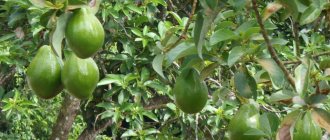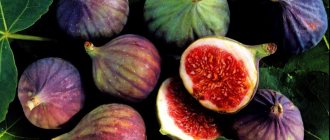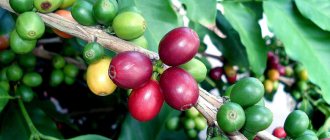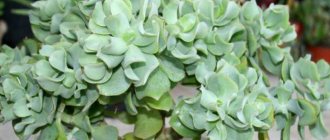- October 13, 2018
- Trees and shrubs
- Ksenia Yedikhanova
Avocados are known and loved by many, this is due to the unusual taste and high nutritional value of the fruit. Large green fruits can be purchased in almost any supermarket, but few people know how and where the avocado tree grows. Is it possible to grow an exotic crop yourself?
Appearance
What does an avocado tree look like? The plant is an evergreen tree that can reach a height of 6-18 m. The tree has ovate leaves with pointed tips, about 10-20 cm long and 2-12 cm wide, in a dark green hue. The flowers of the plant are unsightly, yellow-green in color, collected in small inflorescences in the form of umbrellas.
The avocado fruit is a green drupe with a thick, dark green skin. Its flesh is also green in color, has a slightly sweetish taste and a creamy-buttery consistency. The size of avocado fruits varies from 5 to 15 cm, depending on the degree of ripeness and variety.
The avocado tree can be of three varieties:
- West Indian - suitable for growing in tropical climates with high humidity.
- Guatemalan is a hardy species that grows in subtropical mountainous areas.
- Mexican is the most common variety due to its resistance to slight low temperatures, which other varieties cannot boast of.
Due to different varieties of culture, avocados from different countries may have slightly different appearance and taste.
How it grows in nature
Avocado is a fruit tree of the genus “Persea” of the Laurel family. It has a branched trunk (grows up to 20 meters in height) and a dense evergreen crown. The foliage falls and is renewed all year round. Avocado leaves reach 30 cm in length and have an elongated, rounded shape. The flowers are bisexual, greenish-yellow. They are hidden in the axils of the leaves and are almost invisible against the background of the tree.
Due to the rich dark green hue of the peel and elongated ellipsoidal shape, this plant was called the “alligator pear.” This color is characteristic only of green fruits. As it matures, the color becomes more saturated, almost black.
Under the tough skin there is an oily, fatty pulp of a light light green color. A ripe avocado tastes like pumpkin or cucumber with butter. In the center of the fruit, closer to the blunt side, there is a large elongated bone.
There are varieties whose ripe fruits can reach 1 kg in weight. On average, one fruit weighs about 100 g. Over 200 kg of crops are harvested from one tall tree per season.
To understand where avocados grow in which countries are the most suitable conditions for their cultivation, you need to give a general idea of the soil in which they take root. The trees bear fruit well on sandy and limestone soils, volcanic loam and red clay. The main requirement is moderate humidity and no flooding.
Avocados are grown in warm tropical and subtropical climates with plenty of light. Fruits are exported to Europe all year round from Africa, the Dominican Republic, Brazil, and Israel.
Purchase of planting material
You can try growing an avocado tree at home. To do this, you should take care of good planting material - a seed. It must be removed from ripe fruit purchased in a store. You need to choose the right avocado in order for the seed to germinate. For these purposes, only ripe fruits should be used. You can check ripeness in the following way: lightly squeeze the avocado with your palms, the fruit should take its previous shape after that. If you can’t buy ripe fruit, don’t despair, because it can always ripen at home on the windowsill.
After purchasing an avocado, the fruit itself can be eaten, because only the seed has value for germination. You need to remove it carefully so as not to damage its peel.
How to prepare a bone?
Only ripe fruits are suitable for growing avocados. They can be difficult to find, since either immature specimens or already black ones that have lost their beneficial properties are usually imported into our country. A good fruit should be dark and elastic: when you press on the flesh, a dimple is formed, which quickly straightens out.
It is important to remove the seed without breaking its shell. To do this, make a circular cut, carefully touching the bone with a knife. Take both halves and gently twist in opposite directions. This will help the pulp from one half to gently separate, then carefully remove the pit from the other half using a tablespoon. Rinse the pit and let it dry to prepare for planting.
Planting methods
At home, an avocado tree can be grown in three ways:
- The seed is planted in loose soil with the blunt end down. It is important that the sharp end rises slightly above the surface of the ground. It is necessary to water the seedlings once every 7 days with clean water. This method is the simplest, but you will have to wait a long time for the first shoots, since the roots need to break through the hard crust of the seed.
- You need to punch three holes in the pit. After this, it is placed in water so that the holes are above the surface of the liquid. It remains in this state until germination, after which it can be placed in the ground.
- The last method involves completely clearing the seed from its shell. After this, it is placed in water until roots appear. This method is not only the fastest, but also the most interesting, since it becomes possible to observe the formation of the root system.
Regardless of the chosen method of planting an avocado seed, seedlings appear in 90% of cases, which is considered a fairly high figure.
When is the best time to germinate and plant an avocado seed in the ground: timing.
For these purposes, you need to purchase ripe fruit. Unripe fruits are not suitable, since you will not be able to grow a crop from such a seed. It is worth understanding that the thickness of the peel is quite decent, so you need to initially germinate it in order to then plant it in the soil.
Drop off times may vary. When it’s convenient for you, because at home the temperature conditions are almost always the same. As for seed germination, usually the sprout can be seen after 3 weeks or 3 months. Yes, indeed, the sprout takes a long time to germinate.
germinate and plant an avocado seed
Growing in the ground
After the avocado tree sprouts from the seed, you can begin planting it in the ground. It is recommended to use universal soil for indoor plants, as it has a sufficient amount of nutrients and a loose structure. The soil must be well drained so as not to retain excess moisture, which is detrimental to the roots.
Experienced gardeners suggest adhering to the following planting system:
- drainage must be at least 2 cm in height;
- the bone goes two-thirds into the ground with the blunt end down;
- in this case, the sharp end must remain above the surface of the earth;
- After planting, it is recommended to water the plant with warm water once a week.
To ensure good rooted growth, it is necessary to fertilize the plant once every 2 weeks. In addition, avocado is a light-loving crop, so you should take care of good lighting in the place where the pot is located.
Stages of sprouting an avocado seed
Growing avocados at home from seeds is done in the following sequence.
The seed is extracted. To do this, a small incision is made in the center of the fruit, 1 cm deep, and its bone is carefully cut out using rotating movements. Next, it is washed under running water without damaging the brown shell.
Before germinating an avocado, prepare a place for its growth:
- A drainage system is placed in the pot, for which ordinary gravel or expanded clay is suitable.
- A nutrient mixture is prepared, consisting of equal parts of humus, garden soil and sand. Since avocados can be planted directly into the soil, for the seeds to germinate normally, it must have a loose consistency.
- The prepared mixture is poured into the pot, leaving a little free space, 1–2 cm from the top edge.
How to germinate an avocado seed
The closed method involves germinating planting material directly in the ground. To do this, the bone is placed in the ground 25 mm deep, with the sharp end on top, and watered well, saturating the entire soil. The container is placed in a warm place with good lighting and watered throughout the entire germination period. After 20–30 days, a sprout will appear.
The open method of growing avocados involves placing the seed in a container of water, hanging it. To do this you need:
- prepare a glass or other container;
- in the middle part of the seed, from different sides, make 3-4 holes into which toothpicks are inserted, 2-3 mm deep (they act as a support so that the seed cannot be completely immersed in water, but only its lower part);
- the seed is placed in a prepared container with cold water, with a blunt end, and the planting material should be immersed by 1/3 of it;
- instead of water, you can use hydrogel, which can retain moisture for a long time;
- throughout the entire germination period, you need to ensure that the water level does not decrease;
- after the first root appears, the plant can be transplanted into the ground, but in order for the plant to take root, its roots must be at least 30 mm.
It takes 2 to 6 weeks for the first roots to appear.
Avocado seeds contain a substance called persin, which disrupts the digestive system and causes various allergic reactions. Therefore, it is recommended to carry out work with rubber gloves.
How to care?
How does an avocado grow? Despite the fact that countries with very warm climates are considered its homeland, growing avocados from seeds at home is possible. To do this, you need to know some nuances about caring for wood.
The optimal temperature for the plant is considered to be about +23 degrees, while in winter these indicators can be reduced to +10 degrees. If the temperature is below this mark, it will be detrimental to the young plant.
Flowering begins in the third year of the tree's life. In order to subsequently obtain fruits, it is necessary to have several plants so that they can be pollinated by insects. At the same time, it is recommended to expose the tree outside to direct sunlight in the spring and summer, as this has a beneficial effect on its growth and provides an opportunity for natural pollination.
Watering should also change throughout the year:
- in spring and summer, watering is required as the soil dries;
- in winter, after the soil dries, at least 2 days must pass before the next watering.
It is recommended to use settled water at room temperature. In this case, it is necessary to add fertilizer for citrus crops to the water and fertilize it with this composition once every 2 weeks in the spring and summer.
From the moment of flowering to the formation of fruits, about 6 months pass; during this time it is important to carefully care for the plant in order to obtain high-quality fruits.
An interesting option is to plant three seeds in one pot and then weave the trunks into a braid. At the same time, it is not recommended to make it tight; you need to leave space to compact the stems.
Where and how else is it used in the world?
The avocado seed has found application in various fields.
Dye
When crushed, juice (orange or pink) comes out of the seed. In air it turns red to black. The predominance of red or black shade is determined by the type of exotic.
The juice is used as a non-fading ink or natural dye (food or textile). Fabrics do not fade after washing, they are not afraid of household chemicals.
Preservative
It is a natural preservative that can be added to shelf-stable foods. It inhibits fungus, bacterial growth, and food spoilage.
Decorative material
You can make interesting and useful things from avocado seeds.
Their range is determined by shape and dimensions. This is small plastic:
- figurines;
- hot coasters;
- jewelry;
- frames for large photographs, mirrors or paintings with an exotic subject.
Recently, the world has been struck by an “epidemic” of making crafts from avocado seeds. Perhaps this direction of decorative and applied art is known to the indigenous people of the countries where exotic plants grow. But it was Jane Campbell who introduced it to Western civilization. Being a creative person, this American artist was able to discern not only the culinary potential of the fruit and its seeds. The result was the collection “Avocado Stone Faces” - figurines of forest inhabitants.
Hand made craftsmen cut pendants, key chains, pendants, links of bracelets or necklaces. Each such product is unique.
Treatment of diseases
When growing an avocado tree at home, you should beware of the same diseases that affect many other cultivated plants:
- Phytophthora is a fungal disease that over time destroys the root system. The disease can be identified by the sudden appearance of ulcers on the trunk and leaves of the tree. After detection, the affected plant should be set aside from others and the affected parts should be pruned.
- Spider mites appear when there is high humidity in the room where the avocado grows. It can be identified by yellowing leaves and their falling off. The diseased plant must be sprayed with a soap solution and the affected parts of the tree removed.
- Powdery mildew appears as a white coating on the leaves, causing them to curl. This disease can be controlled with fungicides.
In addition, the avocado tree at home is susceptible to the same pests that affect other indoor plants. These are scale insects, whiteflies, aphids, and mealybugs.
Caring for avocado seeds at home
Be careful when caring for avocados, since all parts of the plant except the fruit contain compounds that are toxic to animals, especially cats.
Temperature and lighting
The tree loves warm and sunny positions, but in summer it is worth protecting it from direct midday rays by moving the pot to diffuse shade. In autumn and winter, when there is insufficient lighting, additional illumination with a phytolamp is recommended.
The temperature during the growing season should be about 22-28 °C, and in winter about 15-16 °C. Prolonged exposure to temperatures below 10 °C in winter and 22 °C in summer leads to leaf fall and death of the heat-loving plant.
Growing herbs on the windowsill
For this reason, you should not grow avocados on the balcony or in the garden in autumn and spring, since temperature changes in the open air can be fatal for them. However, in late warm spring and summer, you can move the pot to the garden or to the balcony, especially if it faces south.
When outdoors, give the tree more attention than usual, as the soil may dry out faster in such conditions.
How to water an avocado at home
A tree in a pot needs moderate but regular watering; the soil should be slightly moist, but not wet. In fact, overwatering is the number one cause of death for potted avocado trees, so always allow the topsoil to dry out between watering.
Excess water leads to the development of root rot and yellowing of foliage, and lack of water causes leaves to curl and wilt. In winter, irrigation is limited, watering moderately once every 10-12 days.
When watering with hard water, the plant suffers from the accumulation of salts in the soil. A sign of salinity is brown leaves that curl and dry out at the ends.
To avoid problems, use rain or melt water. If this is not possible, then irrigate with settled water and rinse the soil thoroughly once every 2-3 months. To do this, lower the pot into a container of water and then allow excess moisture to drain from the drainage holes.
Fertilizers
In the first year of life, the tree is fed with citrus fertilizer, according to the instructions, every 3-4 weeks. Since the roots of the plant are sensitive to salinity, excessive feeding will only cause harm. The best composition is considered to be 10% nitrogen, potassium, phosphorus and 6% magnesium.
Spraying with a complex of copper, zinc, manganese and boron every couple of months in the spring and summer for the first four years of life will allow your green pet to begin the fruiting period. When fruit sets, the potassium dosage is increased to 15%.
Avocado trimming
An avocado from a seed grows very quickly in the first few months, but later its development slows down a little, but still remains quite intense.
The tree grows as a single shoot, so when the avocado sprout reaches about 20-30 cm, cut off the top with leaves to stimulate branching.
Trimming the top to stimulate branching
As soon as the side shoots reach 15 cm, the tips of their tops are pinched.
Growth of side shoots after pruning
The procedure can be repeated next year in early spring. In subsequent years, the growth of the tree gradually slows down, forming a spreading crown, but if necessary, prune the plant at the end of winter. Does an avocado grown from a seed bear fruit? A plant in good conditions will bloom and bear fruit in 4-6 years, but they will not be as large as in nature.
Hippeastrum - preparation for flowering and care
They also take a very long time to ripen, about 6-8 months or even longer, so be patient. Avocado bears fruit for at least 50 years.
Author: Irina Baltaga Updated: February 02, 2021
- Large
- Fruit
- Poisonous
Comments
sonya 07/03/2012 21:34 And if you try not to remove the seed from the fruit, but plant the whole fruit in the ground?... What if the tree grows faster?
I’m simply comparing it with wildlife and the way avocado trees spread their halo of habitat. Here it stands alone in a field, there are no people, no one is picking the fruit. While the fruit hangs on the tree, the seed-embryo collects from the pulp of the fruit everything necessary for life, like an embryo in the mother’s body. If the fruit is lucky (it has not been eaten by birds or animals, it has not become rotten or deteriorated due to environmental conditions), then it may fall to the ground overripe. Then, clinging to its roots, it will grow into the ground, and a leaf will appear from another part of it. Well, if you’re lucky... It could be the same with our hazel, rose hips for example... As an assumption, don’t judge strictly, because not everything was cultivated by people at once. Good luck to you! :) Reply
Irina 07/04/2012 12:22 If we talk specifically about avocados, then they were widely cultivated back in the 6th century AD. Mayan tribes in Central America. By the 15th and 16th centuries, avocado cultivation had spread from Mexico to Peru. After the discovery of America, it was brought to Asia and Africa. Commercial cultivation began in the United States at the end of the 19th century. Wild species of avocado also exist, their fruits are much smaller than cultivars. But avocados don't grow alone in a field, they grow in forests. And somewhere I read that there is a special type of bird for which avocado is a favorite delicacy. They even swallow the bones (I don’t know how they manage to do this) and then the bones come out along with the guano. That is, at the place where the bird empties its intestines, a new tree will grow in that place. The method of reproduction that you described also occurs, only the process is slightly different. “The fruits that set in the off-season are not harvested along with the main avocado harvest, but are left on the tree until fully ripened. Avocados that are overripe on the tree can germinate directly on the branch, while the flesh of the fruit becomes moldy and destroyed, and the sprout takes root when it falls to the ground.”
Answer
Tatyana 07/16/2012 17:05 Hello, Please tell me. My avocado grew two meters tall and sent out one side branch. A month ago I transplanted it into a larger pot (after which it began to actively grow). Now he bent over, as if he didn’t have the strength to hold himself up. What to do? Transplant into a larger pot? Or stick a stick and tie it up?
Answer
Irina 07/16/2012 17:40 I think an even larger pot will not solve the problem. It's better to tie it up anyway. Maybe he hasn’t adapted yet after the transplant, so he bent down.
Answer
Galina Grabovaya 10.26.2012 13:08 I planted an avocado seed last year. Now this tree is 120 cm. Sprawling. Requires a garter to the pin. Cute...
Answer
Update list of comments
Tree pruning
Although the avocado tree does not grow to its maximum size at home, it is necessary to periodically prune it. This way you can control its length and give it the desired shape. Trees that are not pruned have a minimum number of side shoots, grow exclusively in height and, as a result, have an unattractive appearance.
To form a beautiful crown, which can be seen in any photo of an avocado tree, pruning in a pot must be done every spring. In the first year of growth, it is important to shorten the tree after 7-8 leaves, and the side shoots after 5-6. In the future, annual pruning can increase the number of side shoots and control the height of the tree.
How to properly grow avocados in water
The first thing to do is clean the seed. Then you need to lightly stick 2-3 toothpicks into the lower, wider part of the seed from different sides and immerse the seed in water. It will sink about ⅓, toothpicks will not allow it to sink further.
During germination, jars of water should be kept away from direct sunlight. Monitor the water level and, if necessary, periodically change it to clean water.
Avocado seed in water
How long does it take for an avocado seed to sprout? The process usually takes 6-8 weeks. After the roots appear, continue changing the water and wait until the sprout reaches a length of 17-25 cm, pinch the top to start the formation of lateral branches.
The technology of growing avocados in water using toothpicks has some disadvantages, since the damage caused can provoke the growth of fungus, and the toothpick itself can rot.
Some gardeners offer a second method of rooting in water with preliminary germination of seed material and subsequent use of plastic bottles.
Peel and rinse the avocado pits, wrap them loosely in a damp paper towel, and place them in a plastic bag or container with a lid.
Wrap the seed in a damp paper towel
Check once a week. If mucus appears, wash the seeds and wrap them in a new damp towel. When the seeds crack, look for small white roots sprouting from the bottom of each seed, but be careful not to damage them.
The appearance of a small root
When the roots extend beyond the seed part, the avocado seed begins to grow in water using a plastic bottle, the top of which is cut off and placed in a jar of water.
The seed is lowered inside the plastic and water is added to it until the seed is immersed in it with the lower part with the root. The water is still changed once a week for fresh water.
Germination using a cut-off part of a plastic bottle
After a couple of weeks, you can see the formation of shoots and leaves. At this stage, it is recommended to add a drop of all-purpose liquid fertilizer to the water once a month.
Then the seedlings can grow hydroponically for several months. Otherwise, they are planted in the soil for further development and fruit production.
Beneficial features
Despite the fact that growing a fruit-bearing avocado tree at home is quite difficult and time-consuming, the resulting fruit will undoubtedly delight you. In addition to the classic taste, they have the same beneficial properties as store-bought fruits:
- vitamins A and E;
- monosaturated fats;
- antioxidants;
- useful minerals.
Based on the totality of useful substances, avocado fruits are good in that they prevent diseases of the cardiovascular system, have a beneficial effect on the gastrointestinal tract, and are useful for diabetes and cataracts.
Despite its benefits, avocado, like most other fruits, is not hypoallergenic, so it can cause individual allergic reactions. For this reason, it is not recommended to give avocados to children under 14 years of age.
Why is it useful?
The seed accumulates many times more nutrients than the pulp, bark or leaves of the plant.
Its beneficial properties are beneficial to the body:
- Protects vision, heart, relieves blood vessels from cholesterol.
- Makes skin, hair, nails healthy and beautiful, strengthens bones. Slows down aging.
- Kills bacteria, fungus.
- This is a leader in the fight against oncology: it prevents the growth of metastases and “organizes” the self-destruction of leukemia cells.
- The low glycemic index (up to 10) plus a high percentage of oleic acid make it an essential product for diabetes.
- Normalizes the functioning of the gastrointestinal tract, immune and endocrine systems.
The pulp and pit of an avocado can be consumed during the ARVI season.
- In dieters, it reduces blood glucose levels, giving a feeling of fullness.
- Helps prevent epilepsy, treats asthma.
- Being rich in folic acid is beneficial for the female body, especially during pregnancy.
- Solves intimate problems: helps women during menopause, problematic periods; increases male strength.
Avocado pit is recommended for excess weight, atherosclerosis, hypertension, inflammation, indigestion, and depression.
The seed helps produce the happiness hormone serotonin and energizes you. Therefore, a pinch of its powder can be added to your morning tea or coffee. Especially for those who are busy with mental work, have difficulty waking up in the morning or cannot overcome depression.
Features of a home tree
A home-grown avocado has some differences from a naturally grown avocado:
- The height of a tree in nature can reach 18 m, while the height of a home avocado reaches a limit of 2 m. At the same time, it looks quite decorative and interesting.
- It takes a lot of time and effort to create the conditions in which a tree begins to bear fruit, so most often such a tree is used exclusively for decorative purposes.
- If all conditions are created for the plant to bear fruit, its fruits are slightly inferior in size and taste to the imported ones.
- Avocados purify the air, which is why they are popular among gardeners.
In general, growing an avocado does not present any particular difficulties if there is no goal to ensure its constant fruiting.
How long does it take for an avocado to bear fruit in a pot at home?
An avocado tree must reach a certain age before it can bear fruit. Trees sold commercially are grafted from mature avocado varieties and produce fruit more quickly and reliably than trees grown from seed. If you grew your tree from an avocado pit, it will not bear fruit until it is 10 years old and you may have to wait until it is 15 years old.
On the other hand, if you planted a tree from a nursery or garden center, the tree should start producing a crop in three or four years. The first fruits from the moment the seed is planted can be expected from 5 to 13 years. You should not expect a plant in a pot to bloom or bear fruit. Even if there is fruit, it likely won't taste the same as store-bought. If you want fruit, choose a grafted plant.
When does the avocado tree bloom?
A mature avocado tree can produce over a million flowers during the flowering period, most of which drop without fruit. The purpose of mass blooms is to transport pollen. In the wild this means a range of flying and crawling insects, but in Western Australia it is believed to be mainly the European honey bee.
Avocados have a "full" flower with an unusual behavior known as "primitive dichogamy". The avocado flower has both functional male and female organs in one flower, but opens and closes twice in a two-day period—the first day as functionally female and the next day as functionally male. Each initial stage lasts about half a day.
Avocados bloom from late winter to early summer, but most of the fruits harvested come from flowers that are pollinated for two months in the spring. Spring bloom is actually a stressful time for California avocados because the flowers require a lot of resources—sugar, starch, water, nutrients—to maximize their fruiting.
During spring flowering, it is important to walk through avocado groves to ensure each flowering avocado tree receives adequate water and nutrition. Assessing trees will also help you notice weak flowering rates so you can identify the causes and plan ahead to avoid a repeat of poor flowering
How to grow avocados with fruits
Fruit-bearing avocado trees require special conditions to produce a crop. The trees grow best in sandy loam and bear fruit only when grown in a sunny location.
To avoid overwatering, water your avocado trees only when the ball of soil from under the tree crumbles in your hand. Prolonged temperatures above 35°C or below 20°C also lead to reduced yields and fruit drop. Strong winds also cause fruit and leaves to fall off.
Young trees need fertilizing six times a year, about once every two months, and trees 4 years old and older should be fertilized four times a year. Older trees require an additional kilogram of fertilizer per year for each year of tree growth. For trees under 4 or 5 years of age, use nutrient sprays containing zinc, boron, manganese and molybdenum. Spray young trees six times a year.
For older trees, sprays containing zinc and manganese are useful. Spray old trees four times a year. Apply these nourishing sprays at regular intervals between mid-spring and late summer. An avocado tree growing in alkaline soil may be iron deficient. Apply iron chelated primers from early to late summer at intervals according to the manufacturer's directions.
Problems in growing
Growing avocados from seeds can be a very interesting experience for those who have patience. However, sometimes avocados at home can face some difficulties. How to avoid them? The most common mistakes are improper watering, poor soil, temperature imbalance, and disease.
Diseases and pests
At home, avocados may encounter a number of diseases or pests. The most common of them:
- Root rot. Avocado trees are very susceptible to root rot, caused by the soil fungus Phytophthora cinnamomi. Effective rot control includes - good drainage, mulching, use of proper soil, moisture control, timely treatment, inappropriate soil acidity.
- Chemical treatment. Phosphonate fungicide is the best chemical treatment for root rot, either as a regular preventive treatment or as a treatment for the disease.
- Anthracnose. Anthracnose is caused by the fungus Colletotrichum gloeosporioides and is a fruit rot that remains latent until the fruit ripens.
- Beetle with yellow spots. These are serious pests that burn fruit at all stages from harvest to harvest.
It is necessary to constantly monitor the condition of your tree and take timely treatment measures. If necessary, affected leaves and branches must be removed.
Avocado leaves are drying up
The main reason for this phenomenon is dry air. Avocados come to us from humid tropical climates where air humidity is typically at least in the 70 to 80% range and often much higher than that. In many homes, it remains below 30% for much of the fall and winter. And when the air becomes too dry, the loss of water from leaf cells increases. Soon, the large but thin leaves of the avocado begin to lose water faster than the plant can replace it, and when this happens, the cells begin to die, resulting in browning.
To keep your leaves in tip-top shape, you need to maximize the humidity, and the easiest way to do this is with a humidifier. If you can keep the humidity in the 45-55% range (which is also a good level for people and pets), it will make a huge difference. Of course, this is nowhere near the 70 to 80% the plant really wants, but at least it should be able to hold all but the oldest leaves with a brownish coating around the edges.











